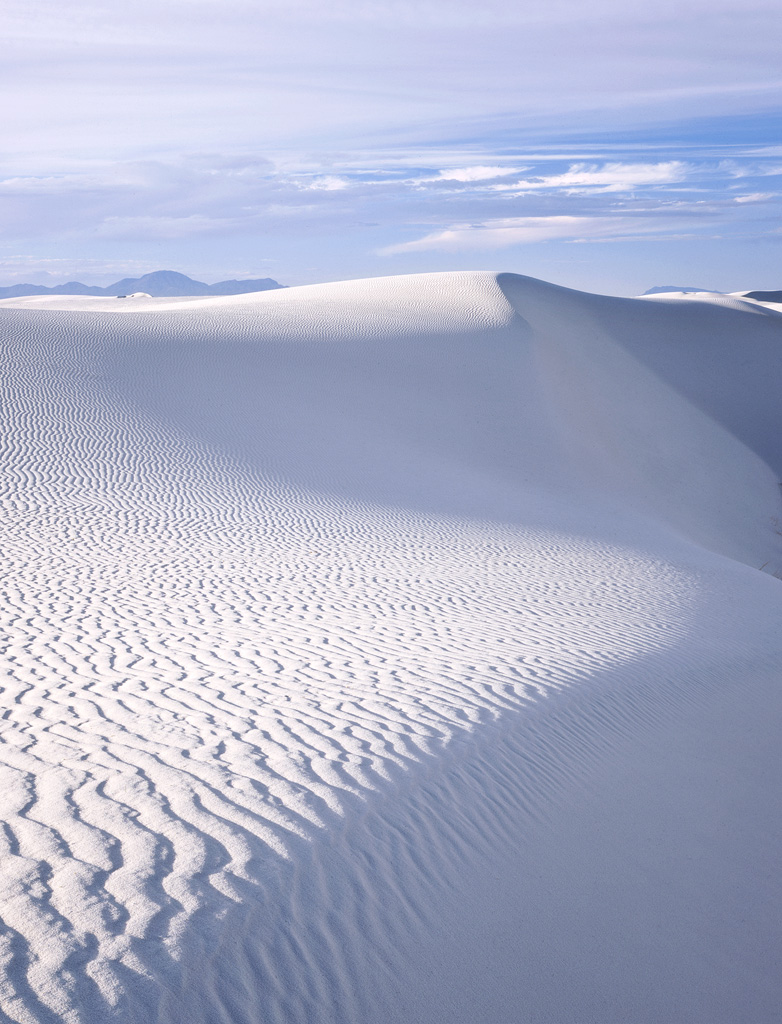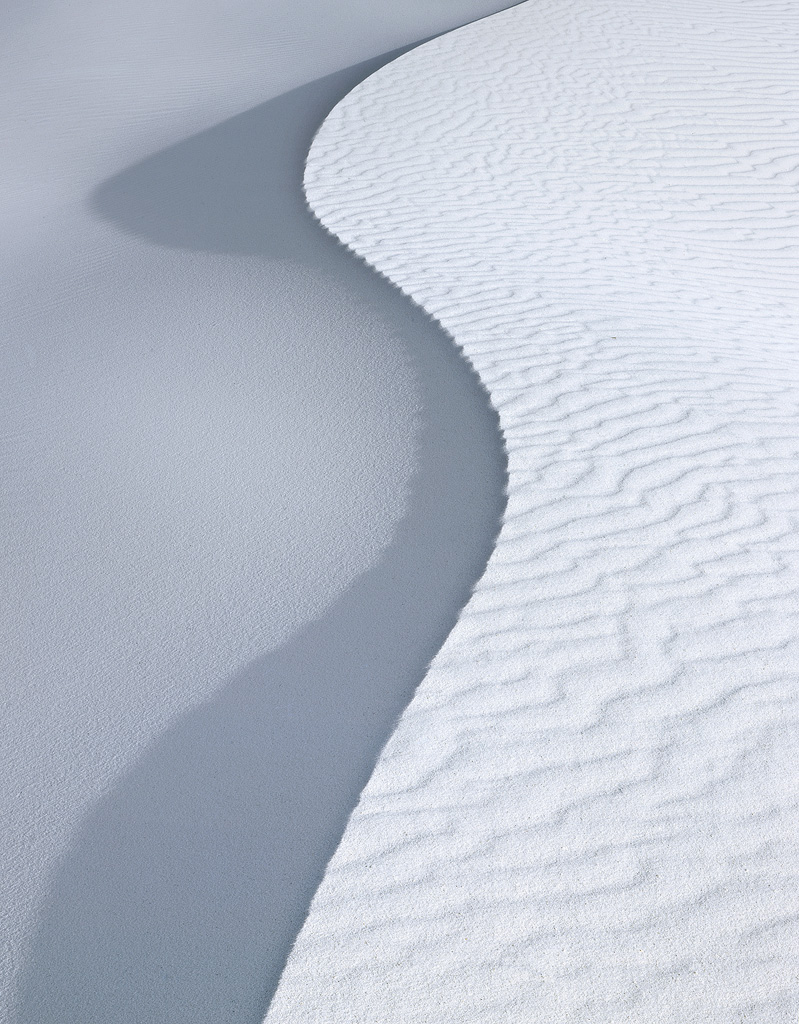A couple weeks ago I took a trip down south to the dune covered desert of White Sands National Monument with Robert Micsak. All I can really say is that this place is truly amazing! The gypsum sand is purely white as far as the eye can see, which means it catches all of the unusual hues of the sun just the way snow does. I was initially unsure of going to this place just because of the odd regulations that come with being in the path a missile testing range. For some reason, the government has decided that this wild and beautiful location would be the best spot in the country to launch missiles for testing purposes. The range covers 3200 square miles and allows for testing flights well over 100 miles. Since the National Monument is in the potential path of these projectiles, it needs to be shut down anytime there is testing. This had me worried as I didn't want to drive 12 hours to come to a closed park. The most important part about planning a trip to White Sands is flexibility. You need to call ahead the day before you leave and make sure there is no scheduled testing. We got pretty lucky, just a week before we went down the park was closed due to a drone crash for 10 days and there was testing scheduled for 10:30am on the day we left to head home.
I'm quite glad we fell into the perfect window of opportunity! We even ended up with wonderfully calm and warm weather, a nice break from the Colorado winter. Sand dunes don't exist without wind, but they can be miserable when it's blowing (check my blog post on Great Sand Dunes last year!) The days were warm in the 70°s and the nights were chilly, but there wasn't a breeze the whole time. We set out onto the dunes in the early afternoon to start exploring this bizarre landscape. The first thing we noticed is how unbelievably bright it is! Sunglasses were barely enough eye protection, it seemed brighter than any snow covered alpine slope on a bluebird day. It's just miles and miles of white sand everywhere.
In many landscapes it's usually not worth trying to photograph in the middle of the day, but dunes are a whole different story. The harsh light brings out the shadows, so as long as the angle of the light is good it doesn't matter if it's high noon. This is particularly true in the winter months when the sun is still at a lower angle. The sun kept poking in an out of the clouds, but eventually gave me enough light to make the above image, my favorite from the trip.
Another thing to keep in mind about White Sands is that you are only allowed to stay in the park if you backpack in with your tent and gear. No car camping is allowed at all, the closest car campground being more than an hour drive away. The park also closes and hour after sunset and doesn't reopen until an 8am, so the only way you'll get a sunrise photo here is by spending the night among the dunes. I quite like the backpacking experience so it worked perfectly for me. The designated camping sites are about a mile hike in from the parking area, and offer plenty of solitude. For those looking for dark skies, this doesn't seem to be the place. The nearby Air Force base created a lot of light pollution, but it didn't help that there were also a lot of clouds overnight. I still decided to take an 8 hour exposure of the campsite for fun.
After a good night's rest (for me anyway, Robert was blowing up his sleeping pad all night after thorns poked a hole in it the night before) we awoke to a beautiful crisp morning and headed back out onto the dunes. I had spotted the above plant the afternoon before and wanted to get a good shot at sunrise. I set up early with plenty of time, all I had to do was wait for the sun to clear some low clouds on the horizon and everything worked out perfectly! This was that soft moment of light that only lasts for maybe 10 seconds as the was still half covered by the clouds, which shows that it pays to be ready early. It's tricky enough having a large format camera set up and ready for a brief moment of light, but you have to have your film ready and meter in just a matter of seconds so you can get the exposure just right.
We wandered around the dunefield for a little while, noticing how incredibly quiet the place is. It was so silent my ears would ring. Well, silent until some fighter jets took off from the nearby Air Force base. Two jets ripped by us overhead, filling the valley with a deep roar before heading up to higher altitude. After a short while we couldn't hear them anymore and thought nothing of them. Robert continued to compose photos under his darkcloth as I wandered around to find some more spots. Suddenly, there was a terrifying BOOM-BOOM BOOM!! that shook the entire earth, my legs and chest. For a split second I wondered if we were subjects in an experimental missile test while Robert threw his darkcloth on the ground and cursed the heavens. It then occurred to me that those planes we had seen an hour before must have broken the sound barrier, something I'd never witnessed before. It seemed louder than anything I had ever heard in my life, especially in contrast to the silence of this place.
Another one of the odd regulations at this park is that you are required to personally check in at the visitor center each day before spending another night, just in case there was some new missile testing scheduled. While you've already driven the 7 miles to the visitor center, you might as well fill up on water or head into Alamogordo for lunch. After reloading film and filling up on nutrients we head back into the dunes for another beautiful afternoon and evening. I found a spot where all you could see was endless white dunes without any vegetation or mountains in the view. I waited until sunset, and when the clouds turned to shades red and magenta the sand also reflected those hues and created colors I had never before seen in the natural world. It was something truly amazing to see.
The morning after this didn't really end up with any light and we needed to get home so we packed up and left by 8am. If you need somewhere to stay or shower on the way into or out of White Sands, I can recommend Valley of Fires near Carizozo. It wasn't the most photogenic place, but had a fantastic campground facility with a shower at a really cheap price. We needed to spend the night there on the way in, so we wandered around the loop trail to get a look at some of the youngest lava flows in the continental US. Hard to imagine this whole place filled with lava just 5000 years ago.
Did you find this blog post helpful? Feel free to make a small donation. By clicking the button below, you can give me a $5 donation easily through PayPal (no account needed) that helps me greatly. Every sheet of my large format film costs about $5 so your donation can keep me out there photographing the beautiful landscape!
Better yet, purchase a copy of my new inspirational eBook "Photographing the Plains" by clicking here!
If you would like any of these images on you walls as prints, please contact me by email or by calling me at (970)412-0679








